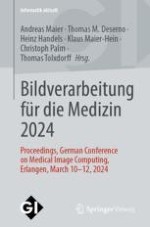2024 | OriginalPaper | Buchkapitel
Abstract: Transient Hemodynamics Prediction using an Efficient Octree-based Deep Learning Model
verfasst von : Noah Maul, Katharina Zinn, Fabian Wagner, Mareike Thies, Maximilian Rohleder, Laura Pfaff, Markus Kowarschik, Annette Birkhold, Andreas Maier
Erschienen in: Bildverarbeitung für die Medizin 2024
Verlag: Springer Fachmedien Wiesbaden
Aktivieren Sie unsere intelligente Suche, um passende Fachinhalte oder Patente zu finden.
Wählen Sie Textabschnitte aus um mit Künstlicher Intelligenz passenden Patente zu finden. powered by
Markieren Sie Textabschnitte, um KI-gestützt weitere passende Inhalte zu finden. powered by
Patient-specific hemodynamics assessment has the potential to support diagnosis and treatment of neurovascular diseases. Currently, conventional medical imaging modalities are not able to accurately acquire high-resolution hemodynamic information that would be required to assess complex eurovascular pathologies. Alternatively, computational fluid dynamics (CFD) simulations can be applied to tomographic reconstructions to obtain clinically relevant hemodynamic quantities. However, enormous computational resources and expert knowledge would be required to execute CFD simulations, which are usually not available in clinical environments. Recently, deep-learning-based methods have been proposed as CFD surrogates to improve computational efficiency.Nevertheless, the prediction of high-resolution transient CFD simulations for complex vascular geometries poses a challenge to conventional deep learning models. In this work, we present an architecture that is tailored to predict high-resolution (spatial and temporal) velocity fields for complex synthetic vascular geometries. For this, an octreebased spatial discretization is combined with an implicit neural function representation to efficiently handle the prediction of the 3D velocity field for each time step. The presented method is evaluated for the task of cerebral hemodynamics prediction before and during the injection of contrast agent in the internal carotid artery (ICA). Compared to CFD simulations, the velocity field can be estimated with a mean absolute error of 0.024ms−1, whereas the run time reduces from several hours on a high-performance cluster to a few seconds on a consumer graphical processing unit [1]
